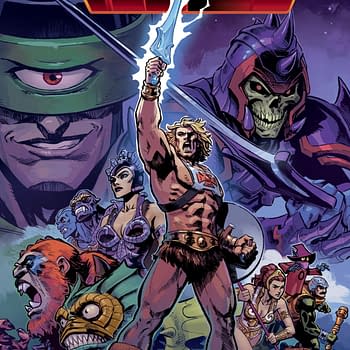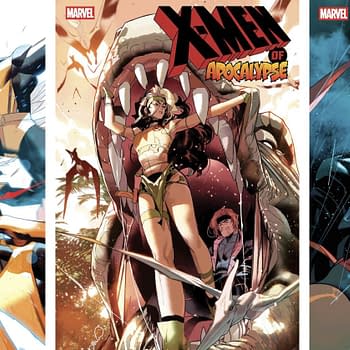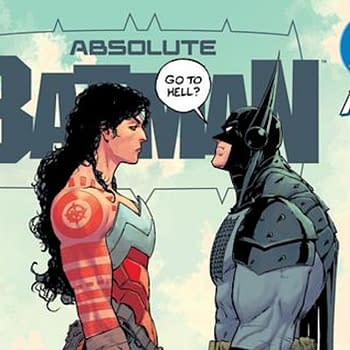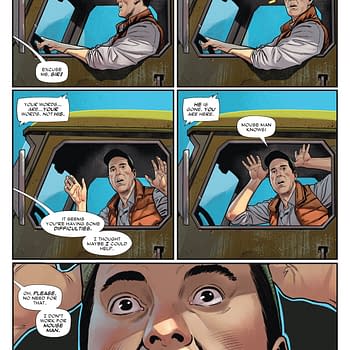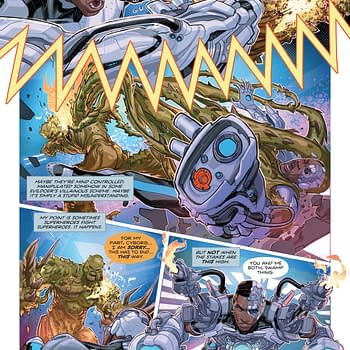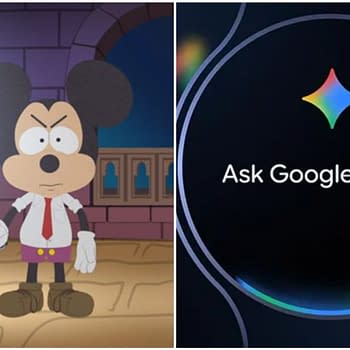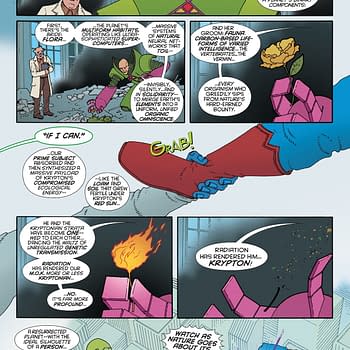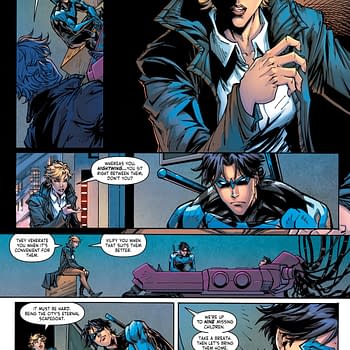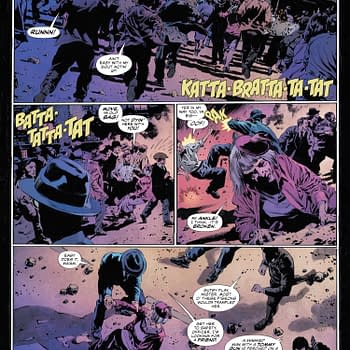Posted in: Comics | Tagged: boom, haunted mansion, slave labor graphics, zombie tales
Talking About Spooky Things With Drew Rausch

If my memory serves correctly, I discovered Drew Rausch's art a few years ago when Gabriel Hardman retweeted one of his posts on Twitter. I really dug Drew's crazy-looking characters and ended up buying a lot of his comics before commissioning a few drawings from him for my collection. Drew is a unique talent and a nice guy, as well. Drew agreed to tell us all about his art and career in comics for this Bleeding Cool interview:
How did you get into comics?
I guess my earliest memory of reading an actual comic was the first issue of Madballs that my Dad bought me off of a spinner rack at a place called the Amazing Store when I was 9. It was an odd place, the Amazing Store. It was tucked in between a bunch of little shops that made up a strip mall. The front half was all toys, magic stuff, comics and it had a couple pinball machines, but the back end was just random bric-a-brac like radios, porcelain figurines, vases – I once found a pack of socks. So among all this STUFF, Madballs #1 caught my attention. Go figure. I think it was because it had a bouncing skeleton head on the cover and I was into goofy monster type stuff. I used to copy the artwork and make up stories about some sort of Mad Scientist.
I don't really think that any one series made an impact, but I read a lot of The Amazing Spider-Man – not because I like Spider-Man – no, it was because I had one of their mail subscriptions, you know the ones that were in the back of the comic, and no matter what box I checked, Amazing Spider-Man would come. I'll tell you that the first horror comic I purchased was a Nightmare on Elm Street comic that I found in a cigarette shop, which was where I got my comics as a kid. It was one of those over-sized magazine books. It had this really sharp, fully painted cover, and a detailed black and white interior. I remember the last page was this splash page of two girls sinking into Freddy's brain. I had never seen anything like that and the ridiculousness of that image stuck with me.

I remember the Madballs comic! I actually had the Madball that looked like a baseball, though I have no idea what happened to it. My mom probably sold it in a garage sale. Anyway, at what point did you start drawing and when did you decide that you wanted to draw professionally?
I drew a lot as a kid. I liked telling stories and getting lost in my own little worlds. I drew mostly spooky stuff. I was always making weird little comic strips on the side of notebooks. I think at some point in my early childhood I wanted to be Don Martin, you know, from Mad Magazine. To me, that guy was a genius at cartooning! There was so much energy in his drawings of people dying horribly (usually with a crazy amount of sound effects).
I didn't really consider drawing as a job until way into high school, because then I HAD to. I was perfectly content making my bizarre 8.5 x 11 comics on cheap photo copy paper, but eventually there was all this talk about "careers" and the typical "What do you want to do when you grow up?" questions. Honestly, I wasn't interested in anything else but drawing and telling stories. Coupled with my love for sequential art and I had found out that someone actually PAID Don Martin ACTUAL MONEY for all those comics, it just seemed like a perfect fit.
My step-brother had a big stack of Mad Magazines that I read when I was a kid so yes, I am very familiar with Don Martin's hilarious art. And now that you've mentioned him, I can see his influence on your work. What other artists influenced you?
A better question would be what artists DON'T inspire me? I see myself as sort of an artistic sponge, soaking up things that peak my interest and then trying to put my spin on it. Since it all depends on how I feel and what I'm working on, to outright name drop I feel would date this interview. My work is often viewed as Tim Burton-y or the likes of Charles Addams or Edward Gorey, which yeah, obviously it is. When I'm asked to describe my style, I just scream "It's SPOOKY!" then vanish in a puff of smoke and bats.
For comics though, my influences are pretty broad. I want to say that I "learned" storytelling from those old EC Horror comics, Tales from the Crypt, Vault of Horror, and the like. Those guys like Harvey Kurtzman and Jack Davis really put a lot of clear information in the small amount of space they had and still managed to squeeze all of those monsters in there. It made me appreciate the art of the short story. Pulling off that type of compression well is impressive. As far as my art interests, they usually skew towards the heavy cartoon and caricature-y. Anything with a lot of energy.
Most of the time I watch movies while I'm working, so there's usually something that will rub off on me from them. I'm not a movie buff or anything, but I own a fair amount. Mostly old cartoons, movies by David Lynch, and horror movies. I have a soft spot for the black and white B-movies you would have seen in a Drive-In. The old Universal Monsters were the BEST, though. Bride of Frankenstein is one of my favorite movies ever. It's the perfect combination of horror and goofiness. At no point did it ever take itself too seriously and that made the horror part MORE terrifying. It's a toss-up between that and the Cabinet of Dr. Caligari. German Expressionism films of the 20's had a HUGE impact on me. It's probably all the weird angles and stark shadows.
I guess I'm constantly looking for anything that shows the weird and unusual aspects of living. Those crude personal moments that the average person dismisses because they don't really know what to do with them. Life, to me at least, seems like it's a series of small, weird and personal events that we all just stumble through. Screaming.
Oh! I also happen to be a big fan of giant monster movies, preferably of the man-in-a-rubber-suit variety. And Muppets.

Was Sullengrey your first published work? Can you tell us how that whole project came about?
Yep, my first published work was Sullengrey. It really was a stroke of luck that that had happened. At the time, I guess it was around 2004, I started going to conventions, standing in portfolio review lines and just trying to get my foot in the door. I didn't really draw superheroes and I wasn't actively pitching a story about a sleepy fictitious town called Autumn's Grove, a place where the fears of its locals manifest and begin to terrorize them. Nope, I think all I had in my book was maybe 4-5 colored pages of a guy in a trench coat who was trying to save a pink haired girl from a zombified bag lady who was trying to steal her nose. There were a lot of positive responses but the editors I showed my art to usually didn't know what to do with my unconventional and crude "style". I had started to rethink my approach.
But at the last minute, and I think it might have been because Eric Powell and Mike Mignola were appearing, my wife and I attended the Small Press Expo in Baltimore one Saturday. While making the rounds, we came across Ape Entertainment's table and that's where I met Brent Erwin. We talked a bit and I handed him a copy of my work. Now it was towards the end of the day, and I was either delirious from hunger or exhausted from being in a tiny room with so many people, but apparently Brent said that they were interested in publishing my zombie story, which in my head I heard "We want to publish gangster stories." Even though I thought that was an odd response, I thanked him AND STARTED WALKING AWAY. Luckily, my wife has much better hearing and called after me to come back. I was in such shock, that before we left the show, I actually went back and asked Brent if he was serious. Soon after, Ape's show runner David Hedgecock and editor Mike Hall finalized things with me and I started work on the first miniseries.
I think "we want to publish gangster stories" will be my new response to all questions directed at me.
Right after Sullengrey ended, you started drawing stories for Slave Labor Graphics' Haunted Mansion comics. How did you get that gig, and are you a fan of Disney's Haunted Mansion ride?
Being asked to draw a few stories in the Haunted Mansion anthology was sort of dream come true for me. I was a foolish mortal that got to share page time with some of the artists and writers I admired. So much talent haunts that book. Not only that, there is no other ride at any Disney park that I am more enamored with (though Mr. Toad's Wild Ride is a close second). I have never seen the supernatural manifest with so much imagination. It's scary, but in a fun way. On my honeymoon, my wife and I rode it 9 times. NINE. When I am so decrepit that my legs resemble brittle decaying sticks, I plan on riding around in a Doombuggie power scooter.
Working on that Haunted Mansion project was something not even Madame Leotta could have foreseen. It turns out that "Supreme Commander" Dan Vado had a relationship with David Hedgecock at Ape and when he was looking for an artist for the story he was writing called "The Mystery of the Manse", David showed him some Sullengrey. I ended up doing a pinup of the Gravedigger and the Hitchhiking Ghosts to start and then a few short stories and a couple of covers. I wish we could have kept that going. One of the biggest challenges with doing a project that has such a lush backstory as the Haunted Mansion is that you just NEED to put every ghastly detail of ALL 999 ghosts in every panel.
The Haunted Mansion ride has so many ideas in it that it's a wonder more stories haven't been done about it.
I expect we haven't seen the end of Gracey Manor in comics. I personally looking forward to what comes of the Guillermo Del Toro movie (and to the publisher who might make some comics afterwards, just so you know, I draw a fancy Hatbox Ghost!).
Moving on, you drew two volumes of The Dark Goodbye, teaming up with writer Frank Marraffino. These books seemed to be right up your alley as well, with all of the Lovecraftian creatures mixed with detective noir. What was your experience like with this project and how did you get hooked up with Frank?
Being chosen to work with Frank on The Dark Goodbye was the project that made comics a full time job for me. It was quite a learning experience, albeit an enjoyable one! It was part of Tokyopop's now long defunct Original English Language line, which mostly consisted of American writers and artists creating new manga formatted books. Frank created a pretty rich, detailed hardboiled world that was just dripping with tentacles. I was extremely lucky that the editors I worked with really "got" Lovecraft and I was able to draw some really horrific beasties. I was actually pretty shocked at some of the graphic violence I got away with. Overall it seemed to be well received, but much like the rest of the line, all remaining copies were rounded up and probably stored away in the great depths somewhere next to Stu Levy's disco shark costume.

Anthologies are always an appealing venue for me. Again, it goes back to the EC Comics I read and that fondness for the short story. You get to have such a wide variety of styles in art and storytelling, too. Ape Entertainment approached me with this series about a group of horror-themed stuffed bears while I was working on The Dark Goodbye. When they were putting together the first book, I learned the creators of Teddy Scares – Applehead Factory – and I obviously shared a fondness for all things horror so it was a pleasure to draw a couple stories for them. It was fun, but one of the troubles I found was trying to get the most acting out of something that basically has no bones or muscle structure. So in my head, I always envisioned them as the kids from the Garbage Pail Kids Movie but covered in fun fur. I can tell you there is no amount of brain bleach that will rid you of those visions. The first script I received involved the effect that parental abuse has on a child's toy and another was a Friday 13th homage – average all-ages family kind of stuff, you know. Most of the stories involved the bears torturing each other, but I was fortunate enough to work on a story that had some emotion to it. It really tugs at the ol' heartstrings when you get to recreate the "Jason boxing death scene" from Jason Takes Manhattan with stuffed animals – let me tell you. I'm welling up just thinking about it now.
The kids from the Garbage Pail Kids movie are never something I like to think about; much less them covered in fur. Thanks a lot, Drew.
Well, you continued with the anthology books when you drew some stories for Boom! Studios' Cthulhu Tales and Zombie Tales, respectively. And on Zombie Tales you got to work with one of my favorite writers, Tom Peyer. What was that experience like?
Around the time that Tokyopop started its descent into reality TV show oblivion, I guess one of my editors on The Dark Goodbye had suggested to Mark Waid that I work on a pretty silly Big Brother style Cthulhu story for Boom!'s Lovecraft-inspired Cthulhu Tales anthology. Having Mark Waid email me and say he was a fan of mine was kind of a big deal. At the time, most people working in "mainstream" comics didn't really know what to with me, I was the weird shy guy with big hair who wore all black and had an affinity for drawing morbid things, so to have someone of his caliber backing me was sort of – I dunno – reassuring. And because I always seemed to be most comfortable with the strange and unusual, I always felt I got the more fun stories to work on. For example, in that Cthulhu House story (which was written by William Messner-Loebs), I got to draw a panel of Cthulhu playing volleyball! Bet ol' H.P. never thought of THAT!
I did two stories for Cthulhu Tales and then moved on to working on a couple of Zombie Tales, one of which was the story that Tom Peyer wrote. "Zombie Come Home". There wasn't much dialogue, but it was this really touching and painfully funny tale of a little boy losing his pet zombie, like Homeward Bound of the undead. Out of all the work I've done so far, the last page is my personal favorite. It's just such a morbid ending to an otherwise heartwarming tale. It really summed up the kind of stories I like to be a part of, that perfect mix of humor and horror.
I encourage everyone to check out that "Zombie Come Home" story you did with Tom, which can be purchased here.
The one book that you've worked on that I was able to give to my nephews is the Shrek comic from Ape Entertainment. Your quirky style seemed to be a perfect fit for that world, and I wish that there had been more of these comics. Were you a fan of the Shrek movies before getting this gig and what was the experience like working on this series?
I have to admit that I only saw the first one, so when Ape asked me if I wanted to do the prequel comic to the FOURTH movie with Scott Shaw! I was shocked because I didn't know there was a THIRD. So no, I wouldn't say that I'm a fan, but I do love fairy tales – more specifically the Grimm variety – and the Shrek world, though whimsical, can skew surprisingly dark, which I found appealing. It was actually a really good experience. Before we started, I was invited to the DreamWorks animation studio to watch some rough Shrek 4 footage and check out where all of the animators work. Seeing all those chains attached to desks was a little awkward at first, but no one ever said making cartoons was easy – or so I hear. Working with some of DreamWorks' editors was probably the closest I've ever gotten to being in the animation industry and I learned quite a bit. For me, it got pretty obsessive sometimes though – drawing Shrek's fart cloud "on model" – that kind of thing. With the prequel comic, I got to work over Scott's layouts, which was interesting because we both have such a different approach. Later on, I even got to design a few new characters for a story that was sort of a twist on Gulliver's Travels. Lot of farting and burping jokes in that one. Kids really like the flatulence, I guess. There was also a sequence that I put together involving a gingerbread man in a daring escape from a shark and then becoming a karate master engaging with some knights in battle. So that was a thing, yeah.
Of all the things I hoped you would keep "on model", I must say that Shrek's fart cloud was #1 on that list. Anyway, let's move on and talk about Eldritch! I felt that this series was bit of a step-up for your art and you just seemed to be having a ball drawing the characters and creatures in that story. I particularly liked how crazy-looking you drew Ted Newbarn, the mentally-unstable dad of the demon baby. How did you and Aaron Alexovich come together for this series and is it different working with a writer who also draws comics?
I'm really proud of the work I did on ELDRITCH! It was sort of a breakthrough, style wise, for me and I can honestly say that I put my heart, soul, and various other body parts Aaron demanded I sacrifice for "the cause" into it.
A couple years back it was suggested to me that I should enter DC Comics Zuda competition by editor Ron Perazza and High Moon writer, David Gallaher. While trying to come up with an idea to enter with, Aaron (who worked on Avatar the Last Airbender, Invader Zim, and was winning over the masses with his creation Serenity Rose) was showing me a pitch for DC's Minx line that never got green-lit before they axed the line. The character designs he did were really weird – remember I like weird – and the story itself had all these Lovecraftian bits in it. That's the one thing I can't ever say no to. I have a Lovecraft addiction, like heroin with tentacles. Anyway, I'd wanted to work with Aaron ever since I met him, and the Zuda thing seemed like a good opportunity. If we won, we'd get published by DC, have a significantly larger audience, and make some money to fund our other creator-owned books Serenity Rose and Sullengrey.
Aaron tidied up the script, which came with some very TINY scratchy thumbnails and soon, we were entered into the April competition. Which we won. And then DC shut down the Zuda line. *cue sad trombone*
Even though we both were a bit disappointed (to say the least), we didn't want to just throw away what we had already done. It wasn't like ELDRITCH! hadn't been received well, or there wasn't a market for it. There were regular emails, Facebook and Twitter messages from fans bummed about the whole Zuda thing, wondering if we were going to finish it. The only real question was how we were going to bring it to the masses. We were in contact with digital comic juggernaut comiXology and a few other publishers at the time of DC's announcement, who wanted to pick up ELDRITCH! Aaron's Serenity Rose book had started out as a webcomic and other former Zuda winners went the self-publishing route, so Aaron and I reopened the dusty tome of Anya Sobczek and her tale of black slopping tentacle fighting once more. Looking at the script again gave me the chance to put the character designs through the ol' taffy pulling machine as well. The things Aaron had planned really required stretching the acting into absurdity. I mean, just LOOK at Ted – how can you NOT like that walking midlife crisis. Within a few months we were off again, helping build the tracks into uncharted digital territory.

At first, we had to adapt Eldritch! from its standard graphic novel roots, since Zuda was using a horizontal format, because its dimensions meant it would fit perfectly on digital devices. It took some getting used to since I hadn't ever worked that way before, but it really opened my dreary eyes to a world of possibilities. Someday I would really like to experiment with what digital media can really offer. There's some really neat stuff being done combining animation and comics.
One of the big adaptations I'm always making is that color prints much darker than what you see on screen, so there's constant editing needed. Other than that, for me, the approach to the actual art is still the same, to find the clearest way to tell the story with the maximum amount of weird and creepy allowed.
Since we're talking about your approach to the actual art, what are your work processes like?
I don't really have a process as much as I just do what feels right. I guess my approach depends on the project. When I'm illustrating someone else's story, it usually starts with a script of some sort. I prefer to have a fair amount of information so I can get a good grasp of what the writer is thinking, but with just enough breathing room that it still feels like a collaboration. In the case of working on my own projects, SULLENGREY for example, there are usually just some short lines of plot or dialogue to remind me what we were thinking that day. From there, I move on to making tiny rough thumbnails approximately the size of 1×2.5" that only I can decipher on whatever paper I have lying about. Sometimes I'll do this on the iPad if I'm away from my art-designated area or sitting on the couch. No details or anything – just trying to lay out the basic idea in my head. These are either scanned or emailed to myself (Which I enjoy doing. Makes me feel important.) and imported into Sketchbook Pro for "penciling" on a Wacom Cintiq. I like to be loose, keep it sort of gestural and try to nail down the shapes of things. From there it's off to inking in Manga Studio, which I find to be the most like inking with a brush pen and then Photoshop for colors.
It might seem silly to use 3 different programs, but I view them as tools – each with their own pros and cons. I like to mix different mediums too, time permitting. Sometimes I'll print out the digital pencils and paint over them or use a dry brush technique with ink for texture. It's really all about using what I think will give me the desired result. I try not to get too nitpicky about the actual steps because it can lead to getting overly obsessive about details and overworking what I'm doing. I don't want any feelings of boredom to come through. The audience can pick up on that. I try to keep it fun, no matter how twisted the subject is. To me, that's the most important step.
Tell us, are there any characters (besides your own) that you would like to work on someday?
That's a tough one. My love for the medium really stems from creating new characters and new situations. But let's say someone asked me if I wanted to work on a Lovecraftian/ Ditko-era Dr. Strange story or do some sort of hyper-stylized, soul-tearing version of Clive Barker's HELLRAISER, I wouldn't say "no."
What was the last really good comic that you read?
I just finished reading Ed the Happy Clown by Chester Brown from Drawn and Quarterly, which was gifted to me by Aaron (Alexovich) with the pretense that "I NEEDED to own it!" He was right. It's the most absurd yet brilliant thing filled with a very unhappy little clown man, pigmies, vampires, and penisusses that just happen to be a miniature Ronald Reagans from an alternate dimension. Funny stuff bordering on the obscenely bizarre.
I've also been reading Shade the Changing Man series by Peter Milligan on comiXology. I had bought the first couple of trades last year and kept up as they were released digitally. It's very surreal. Almost Doctor. Who-ish, but with a more horror feel. And I really dig the early Chris Bachalo art!
Finally, tell us all about "My Blacks Don't Match!"
"MY BLACK'S DON'T MATCH!", which just started on my website www.drewrausch.com, is an expansion of the SULLENGREY series that Jocelyn and I wrote, but in webcomic form. It's not so much a sequel or prequel, but short vignettes that take place in the same town of Autumn's Grove, with some of the same characters – or versions of them at least. We've also made sure to create the story so you don't need to have read the previous graphic novels to know what's going on – it'll be a whole new entry point into the world. It's more about the people living in this town where their worst fears become reality and how they interact with each other. We're also going to be dealing with the weird history of the town itself, something we haven't gotten to do before. There's also going to plenty of ghoulish monstrosities and creepy crawlies causing shenanigans, because if you're not drawing shenanigan-causing creature-y things – what's the point, right?

Not counting the digital release of Eldritch!, this is my first foray into webcomics. It's a bit terrifying, but it's exhilarating at the same time. I hope people come check it out and get their spines tingled and gooses bumped!
Drew Rausch is on Twitter, deviantART, and Instagram. You can read "My Blacks Don't Match!" for free at his website.






